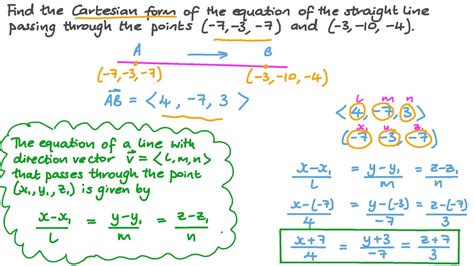Vectors are a fundamental concept in mathematics and physics, used to represent quantities with both magnitude and direction. Cartesian form, also known as rectangular form, is a way of expressing vectors in terms of their components along the x, y, and z axes. In this article, we will explore the concept of vectors in Cartesian form, discuss their importance, and provide practical examples to help you master this essential skill.
The Importance of Vectors in Cartesian Form
Vectors are used to describe a wide range of physical phenomena, such as displacement, velocity, acceleration, and force. In physics, engineering, and mathematics, vectors are used to model and analyze complex systems, make predictions, and optimize solutions. Cartesian form is a convenient and intuitive way to represent vectors, allowing for easy manipulation and calculation.
Understanding Vectors in Cartesian Form
A vector in Cartesian form is expressed as:
v = (x, y, z)
where x, y, and z are the components of the vector along the x, y, and z axes, respectively.
What are the components of a vector?
The components of a vector are the values that describe its magnitude and direction along each axis. For example, the vector v = (3, 4, 5) has an x-component of 3, a y-component of 4, and a z-component of 5.
How do we visualize vectors in Cartesian form?
Vectors in Cartesian form can be visualized as arrows in a three-dimensional space, with the tail of the arrow at the origin (0, 0, 0) and the head of the arrow at the point (x, y, z). The length of the arrow represents the magnitude of the vector, and the direction of the arrow represents the direction of the vector.

How to Add and Subtract Vectors in Cartesian Form
Adding and subtracting vectors in Cartesian form is straightforward. To add two vectors, simply add their corresponding components:
v1 = (x1, y1, z1) v2 = (x2, y2, z2)
v1 + v2 = (x1 + x2, y1 + y2, z1 + z2)
Similarly, to subtract two vectors, subtract their corresponding components:
v1 - v2 = (x1 - x2, y1 - y2, z1 - z2)
Example: Adding and Subtracting Vectors
Find the sum and difference of the vectors v1 = (2, 3, 4) and v2 = (1, 2, 3).
v1 + v2 = (2 + 1, 3 + 2, 4 + 3) = (3, 5, 7)
v1 - v2 = (2 - 1, 3 - 2, 4 - 3) = (1, 1, 1)
How to Multiply Vectors by Scalars in Cartesian Form
To multiply a vector by a scalar, simply multiply each component of the vector by the scalar:
v = (x, y, z) k = scalar
kv = (kx, ky, kz)
Example: Multiplying Vectors by Scalars
Find the product of the vector v = (2, 3, 4) and the scalar k = 2.
kv = (2(2), 2(3), 2(4)) = (4, 6, 8)

Finding the Magnitude of Vectors in Cartesian Form
The magnitude, or length, of a vector is found using the Pythagorean theorem:
|v| = √(x^2 + y^2 + z^2)
Example: Finding the Magnitude of Vectors
Find the magnitude of the vector v = (3, 4, 5).
|v| = √(3^2 + 4^2 + 5^2) = √(9 + 16 + 25) = √50
Finding the Unit Vector of Vectors in Cartesian Form
The unit vector of a vector is found by dividing the vector by its magnitude:
u = v / |v|
Example: Finding the Unit Vector of Vectors
Find the unit vector of the vector v = (3, 4, 5).
|v| = √50 u = v / |v| = (3, 4, 5) / √50

Applications of Vectors in Cartesian Form
Vectors in Cartesian form have numerous applications in physics, engineering, computer science, and mathematics. Some examples include:
- Physics: Vectors are used to describe the motion of objects, forces, and energies.
- Engineering: Vectors are used to design and analyze systems, such as bridges, buildings, and electronic circuits.
- Computer Science: Vectors are used in computer graphics, game development, and machine learning.
- Mathematics: Vectors are used to study linear algebra, differential equations, and geometry.
Conclusion
Vectors in Cartesian form are a fundamental concept in mathematics and physics, used to describe quantities with both magnitude and direction. By understanding how to represent, add, subtract, multiply, and find the magnitude and unit vector of vectors in Cartesian form, you can master this essential skill and apply it to a wide range of problems in physics, engineering, computer science, and mathematics.
Share Your Thoughts
Have you found this article helpful? Do you have any questions or comments about vectors in Cartesian form? Share your thoughts with us and help others learn from your experiences.
What is the Cartesian form of a vector?
+The Cartesian form of a vector is a way of expressing the vector in terms of its components along the x, y, and z axes.
How do I add and subtract vectors in Cartesian form?
+To add two vectors, simply add their corresponding components. To subtract two vectors, subtract their corresponding components.
What is the magnitude of a vector in Cartesian form?
+The magnitude, or length, of a vector is found using the Pythagorean theorem: |v| = √(x^2 + y^2 + z^2).
